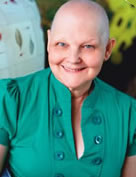Keeping Up Appearances
When cancer changes your looks, the makeover starts inside

As if confronting a life-threatening illness isn't challenging enough for cancer patients, treating that illness often means coming face-to-face with changes in physical appearance, too. Baldness. Scarring. The loss of a breast. The loss of a limb. We offer some strategies for coping with these changes.
Do Looks Really Matter?
When one's health -- or life -- is at stake, do appearances really matter? According to Claire Weiner, L.M.S.W., a social worker in the University of Michigan Rogel Cancer Center's PsychOncology Program, that's one of the first questions many patients -- male and female -- wrestle with. Weiner and the other members of the PsychOncology team are quick to remind patients that it's normal -- not vain -- to be concerned about how we look.
"Our looks are part of our identity," she notes. "Give yourself permission to feel what you're feeling. Even if the loss may have saved your life, you can still grieve it."

When it comes to coping with that new face in the mirror, a strong sense of self-worth and a solid support system are invaluable.
"To be honest, I didn't give my appearance a lot of thought," recalls Diane Argyle, an eight-year breast cancer survivor who lost her hair during chemotherapy treatments.
Argyle brought great resilience to her cancer battle and drew on the understanding of family and friends to put changes in her appearance into perspective.
Kate Muir, who is currently in treatment for breast cancer, remembers looking in the mirror at one point and seeing "an alien, not someone I knew." Eventually, she says, she was able to deal with the changes.
"In my family today, who you are is based on what you do, what you speak, what you feel -- not on how you look," she says. From the very start, Muir's family encouraged her to go out just as she was. Her son, who lives in Ann Arbor, told her, "Who cares? No one cares how they look in Ann Arbor!"
Coming to terms with changes in one's appearance means not only making an emotional adjustment, but making a number of practical decisions as well. Should I get a wig? What types of prostheses and products are available? What else can I do to look and feel my best?

Wig or no wig? The answer is 'yes.'
"I bought an expensive wig, and wore it once," remembers Argyle. "I didn't like the feel of it." Instead, she chose to wear a lightweight hat during the spring and summer months of her chemotherapy.
Muir, too, purchased a wig. "A $29 one," she laughs. She was concerned that her young grandchildren would be upset by her bald head. The opposite proved true. "All three said, 'no -- take it off!'" To this day, the wig makes only occasional appearances -- atop the head of a statue of St. Francis, a sort-of patron saint in Muir's life.
To look your best, focus on feeling your best
For Argyle, feeling better meant getting back to her normal activities, and for that, she turned first to the experts at Personal Touch, part of the U-M's Department of Physical Medicine and Rehabilitation. There, she was professionally fitted with a prosthetic bra, as well as a compression sleeve to relieve the symptoms of lymphedema and help her maintain her arm strength.
"They suggested I wear it when exercising and when out in the sun, but eventually I decided to wear it all the time," Argyle says.

Her other suggestion for people who have had a mastectomy: Make the most of physical therapy and therapeutic massage. "The process helps you heal more smoothly and move more easily," she notes. Massage sessions and the use of special tape keep muscles working correctly and help prevent adhesions, caused when tissue sticks to the chest wall.
Step in front of the camera
A rather unexpected coping tool came Muir's way when a family member told her about the Oldham Project. Based in the Lansing area, this nonprofit is dedicated to providing free portrait sessions to people with life-threatening illnesses.
A photo shoot may sound stressful, but photographer Terri Shaver makes sure it's just the opposite. In a studio filled with music, flowers and candles, she encourages her subjects to relax, and with compassion and a keen artist's eye, she zeros in on the beauty in every face.
After snapping the first picture, Muir recalls, "she turned the camera around and showed me, saying, 'Look at you, you're beautiful.'" The experience was transformative for Muir, allowing her to focus on her inner "warrior princess," rather than her illness. "It was an opportunity to nudge cancer back into its corner," she says.
Keeping Up Appearances Resources
Get more comfortable in your own skin:
Look Good Feel Better
a public service program offered through the American Cancer Society that teaches patients beauty techniques to help manage the appearance-related effects of treatment. For information or to find a nearby program, call 800-396-LOOK (5665) or visit www.lookgoodfeelbetter.org.
Michigan Medicine Personal Touch
offers comprehensive orthotic and prosthetic services, including post-mastectomy products and compression garments. Visit www.uofmhealth.org/medical-services/orthotics+and+prosthetics or call 734-973-2400.
Michigan Medicine Wig Bank:
provides wigs at no charge to Michigan Medicine patients. Call 800-888-9825.
Continue reading the Spring, 2012 issue of Thrive
Continue learning how to overcome the side effects of cancer treatment
- Clearing the Mind: Coping with Chemobrain
- The Weight Battle (weight gain)
- Making the Most of It (pain, lymphedema)
- Life After Treatment (anxiety)
